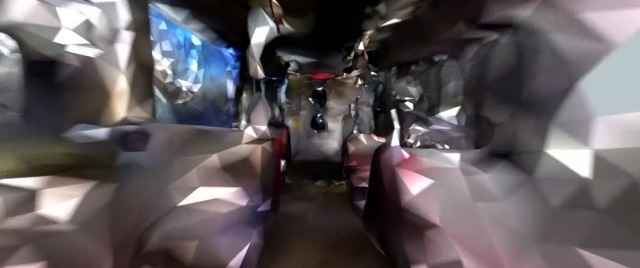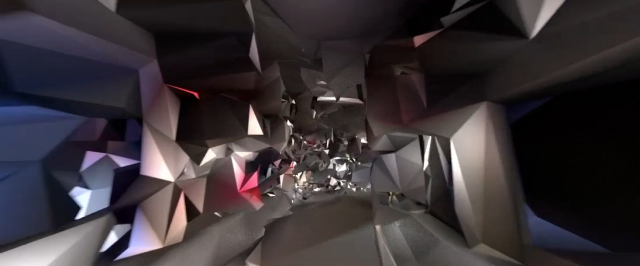METRO Re/De-Construction is a 6 minute video compilation of a series of 3D rendered scenes from a trip along the Denver Light Rail. Artist Chris Coleman created this thought provoking animation by bringing a handheld 3D scanner onto the train he takes to work every morning. He scanned the inside of the light rail cars while the train was in motion, and hopped off the train to walk around and scan stations before catching the next one.

Because Coleman scanned the insides of cars by walking through them with the scanner in hand as the train was moving, the bumps and jostles that resulted from his steps and the movement of the cars manifested themselves in the final image as distortions, moving objects and ripping holes in the readings from a device that is otherwise accurate to the millimeter. The result is a digitally fractured and frayed re/de-construction (as per the title) of an otherwise familiar setting. Because the medium of a 3D render allowed Coleman to explore the world his scanner had recorded, something not unlike an ''out of body" experience has been created in the final video, in which the camera approaches the boundaries of what the 3D scanner could sense. As the viewer travels further down successive train cars the picture becomes more and more abstracted, until finally it collapses at the edge of perception.




What makes this artwork truly special is its perspective from the center of motion. Most artworks that involve digital perception place their instruments as externally as possible, outside the immediate area of change and movement. Morphovision by Toshio Iwai engages with concepts of distortion similar to METRO, combining a spinning 3D objects with projections of lines onto that object to create controlled distortion effects make viewers see a 3D image that does not in actuality exist. Sanctum by James Coupe and Juan Pampin also collects data on a well traveled commute location, but explores the concept of automated profiling based on artificial intelligence. Legible City by Jeffry Shaw is highly similar to METRO in that it is an exploration of a 3D rendering, but allows for greater immersion and less realism; it is more immersive in that viewers operate a stationairy bicycle to virtually ride through a model of a city, but less realistic since the model city has large 3D rendered words instead of buildings. These and many other works place their digital devices above, around, or outside of the action in some way, as this is the best way to gather accurate data or project a stable image. METRO breaks this paradigm by subjecting its sensor to the random, jerky, high velocity conditions that we as humans experience every day of our lives. We do not sit perched on high all day watching the goings down below us, we are at our core transient beings, and thus always in motion. Our perception of the world around us is born out of that state. In particular, this piece draws to mind the words of Herbert W. Franke:
It is now possible through information psychology to give a quantitative expression for optimally perceivable information aggregates. We now find that in the case of periodically changing patterns not more than 16 bits per second of information enter consciousness and that a maximum of 0.7 bits per second can enter the memory; here one bit stands for the unit of information represented by 1 or 0 in a computer store. In the case of static arrangements, the complexity of the picture must not exceed 160 bits – at least not in one plane of observation. (Shanken 205-6)
In this excerpt from Franke's Theoretical Foundations of Computer Art [1971], he talks about how an average person can't store more than about .7 bits of information per second in their memory, and only perceive about 16 bits of information per second. The 3D scanner can store much more information much faster than we can, so the fact that the world in motion us, and later our memory of that world, does not seem as distorted as the image produced by the scan speaks to the enormous power of the brain. They fill in missing bits and smooth out the rough corners of the pictures we build in our minds. It makes you wonder, if you could go back and fly through your memories, would they really be any more organized or complete than METRO?
Bibliography:
Shanken, Edward A. "Documents: Herbert W. Franke: Theoretical Foundations of Computer Art" Art and Electronic Media. London: Phaidon, 2009. 205-6. Print.
